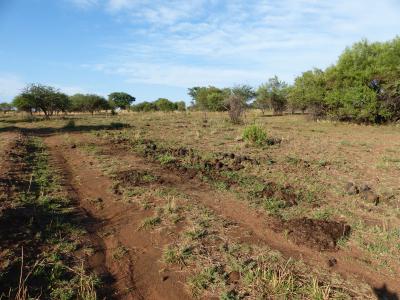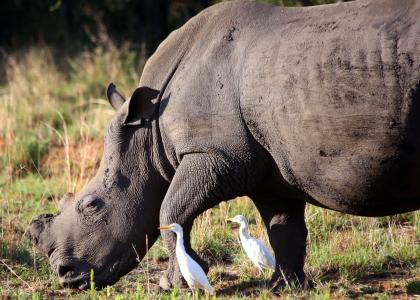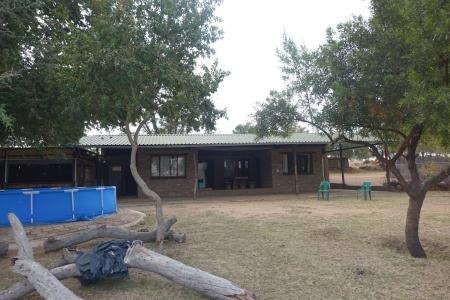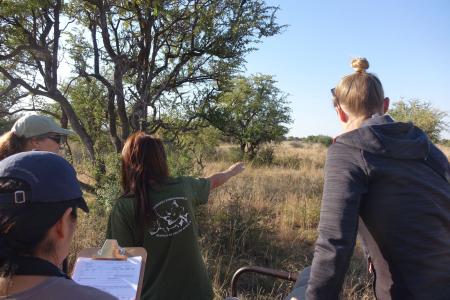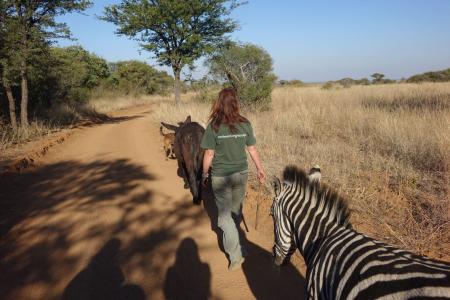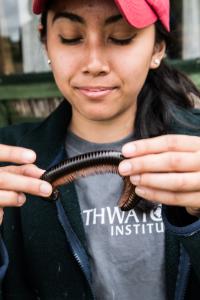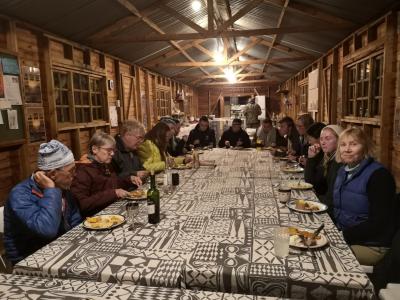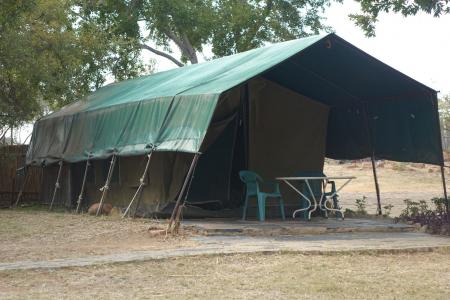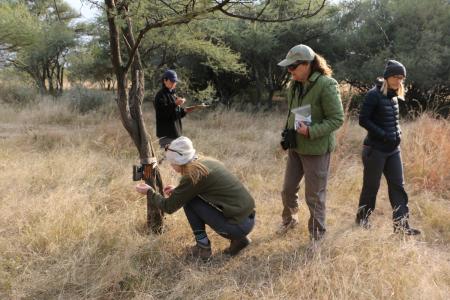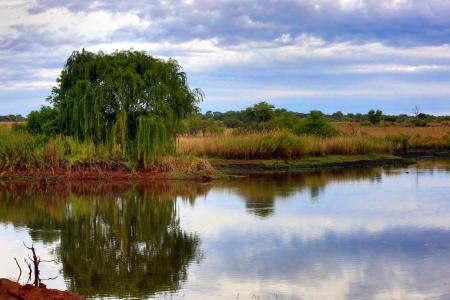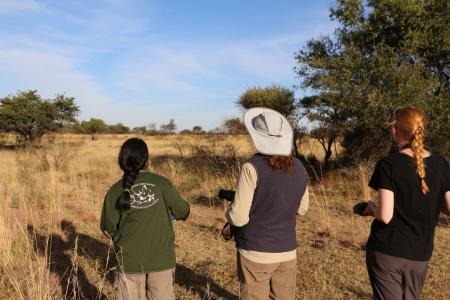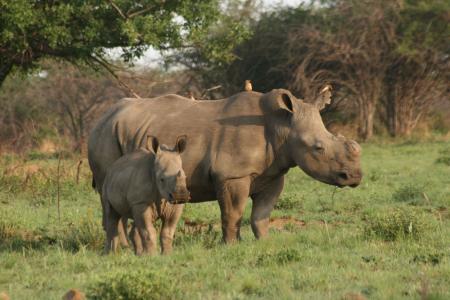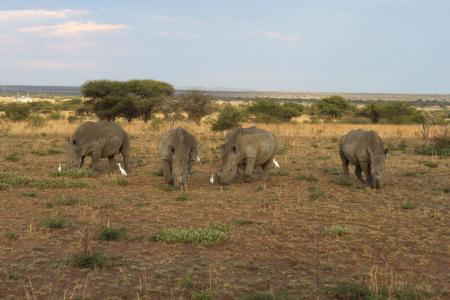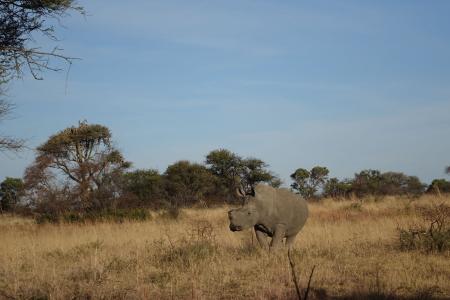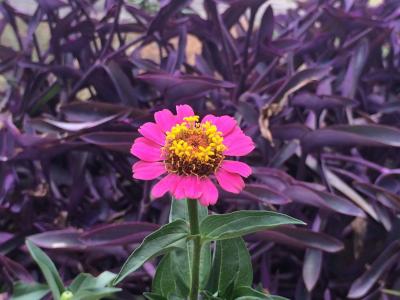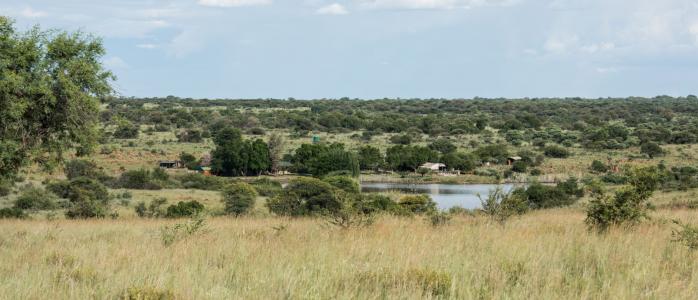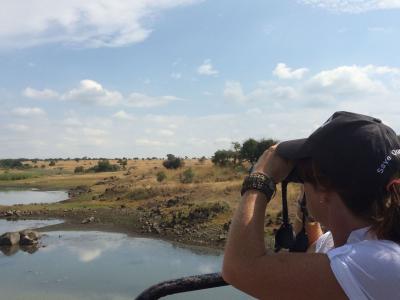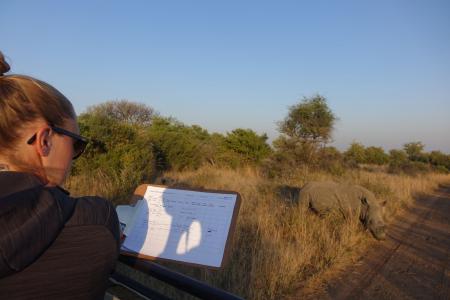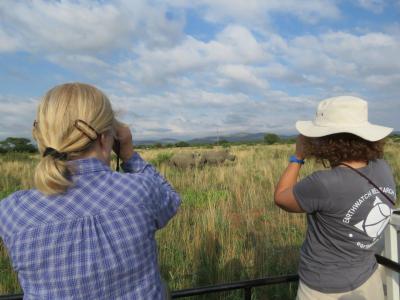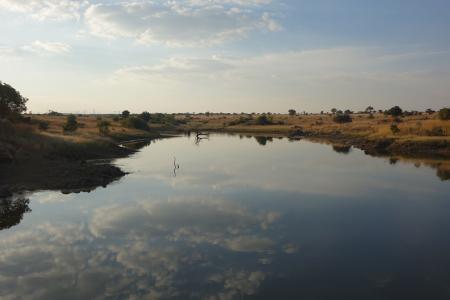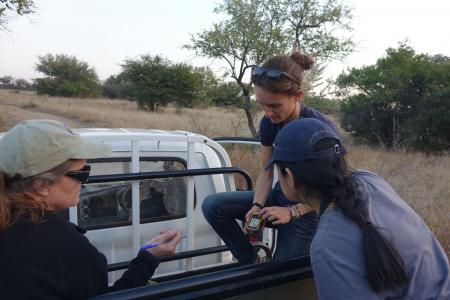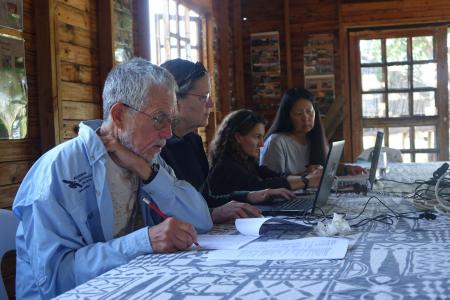.
Please read the following information before leaving for your expedition.
Conserving Threatened Rhinos in South Africa
Expedition Briefing
Quick Navigation: COVID-19 Safety | The Research | Research Aims | How You Will Help | Life in the Field | Accommodations and Food | Project Conditions | Essential Eligibility Requirements | Health and Safety | Project Risks and Precautions | Travel Planning | Additional Resources
Click on the images to view full size!
COVID-19 Safety
You are strongly encouraged to test for COVID-19 before traveling to your expedition, particularly if you are experiencing symptoms. Do not travel if you have tested positive, and call Earthwatch right away for the next steps. Please see earthwatch.org/covid-19 for more information.
The Research
Rhino populations are in crisis due to the high value of rhino horn combined with widespread poaching. From 2008–2015, there was an exponential increase in poaching of both white rhinos and black rhinos in South Africa (Pernetta, 2014), which contains 86% of the world’s remaining rhino population (Emslie et al. 2019). Between 2010 and 2015 a total of 4,843 rhinos were illegally killed in South Africa, with 1,175 deaths in 2015 alone. This amounts to an average of three individuals per day (Pernetta, 2014). Losses to poaching slowly declined after 2015, though challenges in anti-poaching staffing in protected areas due to the COVID pandemic have resulted in a surge since 2020. The latest numbers suggest that, at the current rates of rhino poaching in South Africa, they may become extinct within the next 10–20 years.
This situation requires immediate action not only to reduce the levels of poaching but also to 1) investigate the impacts of anti-poaching actions, including land and animal management (such as rhino horn trimming), on the animals themselves and 2) determine what variables affect rhino behavior and habitat use to help understand, and predict, where they will be found on the landscape. This helps to inform land management and anti-poaching activities.
The goal of the project is to provide information that will help to conserve and manage rhinos in South Africa. We share information with rhino owners on the behavioral and welfare implications of horn trimming and provide supporting evidence on land management practices that may help to identify and reduce poaching risk. In addition, we will demonstrate how rhinos support biodiversity and ecosystem functions, and in so doing, provide further evidence of their inherent value in ecosystem support.
Conserving Threatened Rhinos in South Africa
Research Aims
The research has the following objectives:
- To evaluate the locations and timing of white rhinos using different parts of the landscape in the game reserve, and to determine what might drive those “decisions” in the rhinos.
- To investigate white rhino habitat, use and spatial behaviors, as well as changes in vigilance and social interactions, pre and post horn trimming (or dehorning).
- To identify which deterrents might be deployed to prevent rhinos from using areas of high risk (with respect to poaching) within the reserve.
- To determine what is the most effective, accurate and cost-effective approach for locating poachers following incursions into private game reserves.
- To determine the impact of direct and indirect experience of rhino conservation on an individual’s knowledge, opinion, and action towards rhino conservation.
Conserving Threatened Rhinos in South Africa
How You Will Help
Research tasks volunteers may be involved with:
- Finding and recording locations of individual rhinos every day for group composition, spatial distribution, and habitat use assessment.
- Behavioral observations of rhinos on foot and from vehicles; Observe and record their behavior over set periods of time to determine habitat use, foraging activity, and interactions between individuals of different ages and genders, and determine the extent of behavior to indicate vigilance in relation to perceived threats.
- Recording foraging signs of rhinos and assessing foraging behavior from visual, observational, and vegetation surveys.
- Conducting vegetation surveys: When the animals move off foraging sites, record the vegetation composition and height in the area to assess habitat use.
- Walkover surveys for rhino hotspots, poaching hotspots, and habitat mapping.
- Behavioral analyses of rhinos at inaccessible sites from camera trap videos.
- Helping set up deterrent experiments and monitoring rhino responses to those deterrents. This may include assessing the efficacy of ultrasonic (very high frequency) deterrents.
- Acoustical tools may be used to assess rhino vigilance, with volunteers observing rhino behavioral responses to the playback of two animal vocalizations, one neutral and one a potential threat.
- Assisting with simulated poacher incursions, including helping with on-foot and drone-based surveys.
Conserving Threatened Rhinos in South Africa
Life in the Field
You’ll have one or two days of training in field and survey techniques, behavioral methods, use of GPS and field equipment, and identification of key vegetative food resources. Other educational opportunities will happen throughout the expedition, covering topics such as the history of the project; health and safety on site and during fieldwork; rhino ecology and conservation; rhino conservation and management in South Africa; methodological theory and practice; game reserve management; research methodology; basic field skills, distance estimation, use of GPS, species identification, and more.
DAILY ACTIVITIES
Weather and research needs can lead to changes in the daily schedule. We appreciate your cooperation and understanding.
Project activities may also vary seasonally. Below is an outline of what is likely to happen on each team, but the exact schedule & activities will depend on the project’s current needs and will be set at the start of each expedition.
ITINERARY
- Day 1: Meet and travel to the field site, introduction and orientation drive, downtime in the evening.
- Day 2: Orientation, field training in methodology, group activities, downtime in the evening
- Days 3–7: Rhino monitoring, behavioral observations, habitat mapping/surveys, walking transects and camera trapping, ultrasound deterrent & vigilance-playback studies.
- Day 8: Recreational day with an optional excursion to Pilanesberg National Park and other team activities (park entry fees are covered; meals and snacks are at your own expense)
- Days 9–10: Rhino monitoring, behavioral observations, habitat mapping/surveys, drone studies and camera collection, ultrasound deterrent & vigilance-playback studies.
- Day 11: Data collation, project summary, and sundowner evening at field site.
- Day 12: A transfer company will pick up the team at 12:00 p.m. and take you to the airport for departure.
RECREATIONAL DAY
For safety reasons, the team will spend the recreational day as a group. You will have the option to stay at the accommodations to rest, but you cannot leave camp or go off on your own if you choose this option. Pilanesberg National Park entry fees are included in your contribution cost, but participants must bring spending money for food and drink while offsite.
Conserving Threatened Rhinos in South Africa
Accommodations and Food
* Please note that not every expedition has couples’ or single's accommodations available. Please call or email Earthwatch to check for availability prior to reserving your space(s) on the team.
During the expedition, your team will be based at a campsite in the heart of a private wildlife reserve at a scenic spot overlooking a dammed lake.
SLEEPING
Accommodations will be shared. Most volunteers will share a sleeping area with one or two others of the same gender. Although not guaranteed, it may be possible to accommodate couples or single room requests, depending on group size, on a first-come, first-served basis. Please inform Earthwatch if you would like to request these options.
There are three different accommodations at the reserve. You may sleep in a two-room brick house, a wooden cabin, or a walk-in safari tent, depending on the number of team members.
The house sleeps up to eight people in two separate bedrooms. There are three tents that have an en suite bathroom with flush toilet, sink, and shower. There are two 2-sleeper wooden cabins available with ensuite facilities. There are also two large wooden cabins which each sleep four people with ensuite toilet, shower and sink facilities. We aim to put up to two people per cabin, but this cannot be guaranteed. Beds, pillows, duvets, and sheets are provided, but you must bring your own warm sleeping bag during the winter months (June, July, and August). Sleeping bags are not necessary for teams during the South African summer (October–January teams). A camp attendant will sweep up and sanitize bathroom facilities.
* Earthwatch will honor each person’s assertion of gender identity, respectfully and without judgment. For both teen and adult teams, where logistics dictate single-sex accommodations or other facilities, participant placements will be made in accordance with the gender identity the participant specified on their Earthwatch Participant form and/or preferences indicated in discussions with Earthwatch.
BATHROOMS
Bathroom facilities include hot showers and flush toilets. Hot water is supplied by a wood-fired or gas boiler.
ELECTRICITY
The electricity at the site is generated by solar power. It is 220/230 volts AC, 50 Hz. Most plugs are Type M (three round pins) but some plugs with two smaller pins are also found on appliances. U.S.-made appliances may need a transformer. The campsite has electrical outlets, so cameras, cell phones, iPods, etc. may be charged during the day. Please do not bring unnecessary electrical equipment, as the system at the campsite is easily overloaded and charging capabilities will be limited. This will help preserve energy for other camp necessities. Some equipment (e.g., rechargeable batteries) can be charged at the Wildlife Reserve with the permission of Operations Manager Lynne MacTavish. We advise, though, that you make sure to bring all batteries required for camera equipment, etc. as it can be very hard to find them locally. Please also bring the correct adaptors for South African plugs.
PERSONAL COMMUNICATIONS
The cellphone reception at the camp has greatly improved, so volunteers can use smartphones to gain access to the Internet. Please ensure that you register for international roaming in your own country. SIM cards may be purchased at the Johannesburg airport upon arrival. MTN service provider has the strongest reception in our area. The Internet connection is very slow, so it is impossible to video call at the reserve. You can’t connect your own computer to the Internet at camp; in the case of an emergency, Lynne will bring her laptop with Internet connection to the camp. It may be possible for project staff to download photos onto a computer if you bring appropriate cables, etc. If you’d like a copy of photos taken during the expedition, we suggest you bring a memory stick.
Please note: Personal communication with outsiders is not always possible while participating in an expedition. Earthwatch encourages volunteers to minimize outgoing calls and immerse themselves in the experience; likewise, family and friends should restrict calls to urgent messages only.
DISTANCE TO THE FIELD SITE
The reserve is about a 15-minute drive from Pilanesberg National Park’s entrance. The team will be transported around the Wildlife Reserve in open-topped vehicles, but closed vehicles will be used in the National Park and on public roads. There are no services within walking distance. The nearest town is Mogwase, a 15-minute drive from camp.
FOOD AND WATER
A local chef will prepare breakfast, lunch, and dinner. Lunch and dinner will be a mix of international and local cuisine, including traditional South African meals such as poitjiekos (game stews) and braais (barbeques), using free-range game from the game reserve.
Most meals will be eaten communally and distanced on-site in the eating area.
Lynne runs an on-site shop that sells snacks, drinks, postcards, and project merchandise, such as T-shirts and hats. To make purchases at the shop, place your order in the order book provided, and Lynne will bring the requested items that evening or the following day. Your shop bill will be calculated at the end of your stay. Lynne takes Great Britain Pounds, U.S. Dollars, and South African Rand as well as credit or debit cards; traveler’s checks may not pay shop accounts.
Alcohol consumption is not permitted by minors or on teen teams, regardless of local law. It is permitted on adult teams and available for purchase at the camp.
TYPICAL MEALS
The following are examples of foods you may find in the field. Variety depends on availability. We appreciate your flexibility.
- Breakfast: Cereal, fruit, toast/bread, jam, tea, coffee, occasionally hot breakfast
- Lunch: Salad, quiche, soups, bread rolls
- Dinner: Braais, stews, pasta, potatoes, vegetables, vegetarian options, dessert
- Snacks: Fruit, biscuits, crisps (potato chips); chocolate, etc. may be purchased from the on-site shop at your own expense
- Beverages: Clean drinking water available on site
SPECIAL DIETARY REQUIREMENTS
Please alert Earthwatch to any special dietary requirements (e.g., diabetes, lactose intolerance, nut, or other food allergies, vegetarian or vegan diets) as soon as possible, and note them in the space provided on your volunteer forms.
We can accommodate vegetarian, vegan, gluten-free, nut-free, and lactose-free diets, but very specialized diet accommodation is not guaranteed and can be very difficult due to the availability of food, location of field sites, and other local conditions. If you have special dietary needs it is recommended that you bring supplemental snacks.
Conserving Threatened Rhinos in South Africa
Project Conditions
GENERAL CONDITIONS
For weather and region-specific information, please visit Wunderground.com and search for your project location.
Conserving Threatened Rhinos in South Africa
Essential Eligibility Requirements
All participants must be able to:
- See clearly (with or without corrective lenses) to 500 meters (1,640 feet) and see close up to read research instruments. We may go out in the evening or for a night drive, so the ability to see in low light is also a must.
- Walk over rough, uneven terrain with areas of dense, thorny vegetation, animal holes that can be hard to spot, or rocky and steep slopes for up to five kilometers (3.0 miles) per day with minimal fatigue. The hiking pace is slow and steady, with walks up to three hours per day at an average rate of 1 kilometer (0.6 miles) in 15 minutes.
- Tolerate long periods of time in the field; days can be long.
- Without assistance, climb in and out of project vehicles, which may include vans, trucks with high beds, and open-topped safari vehicles.
- Sit or ride in project vehicles with your seatbelt fastened and in close proximity to other team members while traveling over rough and bumpy roads or have to sit still during behavioral observations for up to approximately five hours per day. Although the team will take regular breaks, in some research areas you will not be permitted to get out of the vehicle and walk around due to the presence of dangerous animals.
- Get low enough to access and collect samples and identify plants on the ground and in the brush, and to access or set up camera traps.
- Enjoy being outdoors all day in all types of weather, often exposed to the sun for long periods of time or highly variable weather conditions, which may include large temperature differences between night and day and sudden storms or drops in temperature
- Enjoy being outdoors in the potential presence of wild, dangerous animals, including snakes and insects.
- Keep as quiet and still as possible while observing animals and working in the bush.
- Tolerate some smoke in the air if participating in the controlled-burn monitoring. Those who choose to participate will be placed in areas unlikely to be affected by smoke—but winds can change, and it is impossible to guarantee a smoke-free zone (only applicable to May–August teams).
- Tolerate not having a reliable source of electricity throughout the night for the length of the project.
- Follow verbal and/or visual instructions independently or with the assistance of a companion.
- Take an active role in your own safety by recognizing and avoiding hazards if and when they arise (including, but not limited to, those described in Earthwatch materials and safety briefings). Always comply with project staff instructions and recommended safety measures.
- Be able to effectively communicate to the staff if you are experiencing distress or need assistance.
- Be able to get along with a variety of people from different backgrounds and ages, often in close proximity, for the duration of your team.
- Be comfortable being surrounded by a language and/or culture that is different from your own.
Conserving Threatened Rhinos in South Africa
Health and Safety
EMERGENCIES IN THE FIELD
Earthwatch has a 24-hour, 7-day-a-week emergency hotline number. Someone is always on call to respond to messages that come into our live answering service.
IMMUNIZATIONS & TRAVEL VACCINATIONS
Please be sure your routine immunizations are up to date (for example, diphtheria, pertussis, tetanus, polio, measles, mumps, rubella, and varicella) and that you have the appropriate vaccinations for your travel destination. Medical decisions are the responsibility of each volunteer and their doctor. Visit the Center for Disease Control and Prevention or the World Health Organization for guidance on immunizations.
If traveling from countries or regions where yellow fever is endemic, you must have a certificate of vaccination.
It is strongly encouraged that you stay up to date with your COVID-19 vaccinations, including receiving booster doses, as applicable.
Conserving Threatened Rhinos in South Africa
Project Risks and Precautions
TRANSPORTATION
Hazards include fast and reckless drivers, livestock and wildlife in the road, rain, poor lighting, banditry, tire punctures due to thorny brush, and vehicle breakdowns. Traffic moves on the left side of the road. South African road conditions are considered good, particularly in urban areas; however, roads at the study sites can be poor: dirt, gravel, or corrugated and very bumpy and either dusty or muddy and slippery depending on weather conditions. Wear seat belts whenever they are available and remain seated when the vehicle is in motion. Speeds will be kept at 50 km/ hr. (30 mph) or below and will usually be around 30 km/hr. (20 mph). Only authorized, insured, and experienced staff will drive. Volunteers are not permitted to drive. We will avoid night transportation (although game drives at night may be included as part of the overall experience).
WALKING/HIKING/CLIMBING
Terrain can be rocky, steep, and uneven with thick vegetation, especially in the wet season. There may be animal holes in the ground which are covered by grasses and hard to spot. Some areas have dense, thorny acacia scrub. There is a possibility of sprains, bruises, and strains when walking. Walk carefully and attentively and be aware of your surroundings at all times. We will walk on tracks and paths where possible. Appropriate clothing and footwear (e.g., long trousers, hat, socks, and well-broken-in hiking boots with ankle support) are required for fieldwork. Closed-toed shoes must be worn at night.
CLIMATE/WEATHER
Most project-work happens outdoors, so sunburn, dehydration, and other heat-related illnesses are risks. Please wear high-factor sunscreen, dress appropriately, and wear a wide-brimmed hat and sunglasses. Carry and drink plenty of water during the day and inform a staff member if feeling tired or ill. Warm layers should be carried for early morning or evening activities.
ANIMALS AT ACCOMMODATIONS
Several types of snakes are present in the reserve, including venomous snakes.
Three domesticated cats live at the Wildlife Reserve, as do dogs. Those with allergies should note this on their participation forms and bring medication as appropriate.
PERIMETER FENCE
The reserve perimeter fence is electrified because of wildlife. Do not touch this fence to avoid shock.
BITING INSECTS (TICKS, MOSQUITOES, SCORPIONS, FLIES AND WASPS) AND VECTOR-BORNE DISEASES
Trypanosomiasis, leishmaniasis, chikungunya, tick bite fever, dengue, and West Nile virus are present in this region. Participants are advised to use insect repellent (20–30% DEET) and wear neutral-colored field attire with long sleeves and long pants tucked into socks. Participants with potential for allergic reactions to insect bites should bring appropriate medications (antihistamines, at least two Epi-Pens as necessary). Volunteers will be informed about where ticks may be more prevalent in the field and how to avoid them. Participants and staff will be reminded to thoroughly check their skin and clothes for ticks daily. If a tick is found, participants will be instructed how to remove it properly and the area will be cleaned with soap and water. Malaria is not present at the research site; however, it is found elsewhere in the country, including chloroquine-resistant malaria.
PLANTS
Some plants may be poisonous if eaten or if they come into close contact with open wounds. Several plants, such as acacias, have large thorns that can cause injury. Staff will help you identify harmful plants. Certain plants and pollen may cause allergic reactions (e.g., hay fever) in some volunteers. Those with allergies should bring and carry medication as appropriate and identify themselves to staff.
LARGE ANIMALS
Many large, potentially dangerous mammals, including lions, rhinos, buffalo, and elephants, live in the region. All wild animals can be dangerous. Do not approach, antagonize, or tease any animal. Because of wildlife, you may not leave the research camp (as defined by the lawns surrounding the camp, beyond which is tall grass). Teams may travel in open vehicles at sites with no large predators. When traveling in Pilanesberg National Park, where dangerous wildlife is present, the team will ride in closed vehicles. In Pilanesberg, you are strictly forbidden to lean or climb out of the vehicle windows. You may only exit the vehicle at tourist hides and at the Pilanesberg Visitors Centre. Field rangers will accompany groups in areas with large, dangerous animals and will carry weapons for your protection. Rangers are well trained in weapon use. Volunteers will NOT be permitted to handle weapons at any time. Weapons are kept unloaded unless the teams are walking transects. When with armed rangers, walk in single file and always stay behind the guide. Keep within five meters of the person in front of you, be as quiet as possible, and wear earth-toned clothing. Always obey the guide and be aware of your surroundings.
MONITORING FOR EVIDENCE OF POACHING
While this optional task is scheduled for times when poachers are not typically active, encountering a poacher is always possible. Those who take part in this activity should heed the instructions of the project staff, scouts, and/or trackers at all times. Do not engage with a poacher should one be encountered.
ANIMAL HANDLING AND RABIES
You may participate in animal handling. Potential risks are bites or scratches. If you participate, you’ll receive instructions and a safety briefing, and be supervised or assisted at all times. You may not handle animals unless under the direct supervision of trained project staff. Protective equipment (e.g., gloves) will be provided where required. Always wash your hands after handling an animal. Animals known to carry Rabies will not be handled, however, you may wish to consult with their healthcare providers about the vaccine given the prevalence of loose and stray dogs in the region. There are several anti-poaching dogs on site as they are part of the anti-poaching unit. You may be allowed to approach these animals when you are instructed and told it is safe to do so. Always avoid stray dogs.
FIREARMS
Field staff may carry firearms during research and non-research activities. The firearms are mainly for firing warning shots in the event of an animal encounter. This is standard practice in a bush environment. Only trained field staff will handle firearms. Volunteers will not hold or use firearms while on this project.
PERSONAL SECURITY
In Johannesburg, as in other large cities, robbery and violent crime are serious concerns. If you will be traveling in urban areas in South Africa before/after the expedition, we advise you to stay alert and use sensible precautions. Avoid dark areas, don’t walk alone at night, and do not obviously display cash, cameras, or jewelry. Criminal activity has been noted in and around the arrivals hall at O.R. Tambo International Airport. Be vigilant, look after luggage, and only use official taxis or other trusted transport providers. It is always good practice to leave unnecessary valuables at home. A guard or watch is assigned to patrol the camp area overnight.
DISEASES
In addition to the insect-borne diseases described above, leptospirosis, schistosomiasis, filariasis, Rift Valley fever, brucellosis, HIV/AIDs, hantavirus, avian/bird flu, tuberculosis, cholera, plague, and typhoid are also found in South Africa. Traveler’s diarrhea also affects many international travelers. Please see the CDC (cdc.gov) or WHO (who.int) websites for more information on these conditions and how to avoid them, or consult with a travel doctor.
RISK OF COVID-19 OR OTHER RESPIRATORY ILLNESS
Earthwatch strongly encourages you to take precautions to help protect yourself and others from common viral respiratory illnesses, including COVID-19, flu, and RSV: stay up to date with your vaccinations; wash your hands frequently; take steps to improve air quality, for example, by increasing ventilation indoors or gathering outdoors; and use preventative measures to limit the spread if you are sick.
Persons with a higher risk of severe respiratory illness should consult their healthcare provider before participating.
Conserving Threatened Rhinos in South Africa
Travel Planning
RENDEZVOUS LOCATION
Johannesburg O.R. Tambo International Airport, South Africa.
* Additional information will be provided by Earthwatch to meet your team. Please do not book travel arrangements such as flights until you have received additional information from Earthwatch.
ABOUT YOUR DESTINATION
Earthwatch strongly recommends that travelers investigate their destination prior to departure. Familiarity with the destination’s entry/exit requirements, visas, local laws, and customs can go a long way to ensuring smooth travel. The U.S. Department of State's Traveler’s Checklist and Destination Guides are helpful resources. For LGBTI travelers, the U.S. Department of State's LGBTI Travelers page contains many useful tips and links.
COUNTRY AND PROJECT ENTRY REQUIREMENTS
You are responsible for reviewing and abiding by your destination's entry/exit requirements.
Entry visa requirements differ by country of origin, layover, and destination and do change unexpectedly. For this reason, please confirm your visa requirements at the time of booking and again 90 days before travel. Please apply early for your visa (we recommend starting six months before the start of your expedition). Refunds will not be made for volunteers canceling due to not obtaining their visa in time to meet the team at the rendezvous. You can find up-to-date visa requirements at the following website: travisa.com.
If a visa is required, participants should apply for a TOURIST visa. Please note that obtaining a visa can take weeks or even months. We strongly recommend using a visa agency to expedite and simplify the process.
Conserving Threatened Rhinos in South Africa
Resources
ARTICLES
- Du Toit, R. & Anderson A., (2013). Dehorning rhinos. Wildlife Ranching. Autumn: 82-85
- Emslie, R. H., Milliken, T., Talukdar, B., Burgess, G., Adcock, K., Balfour, D. & Knight, M. H. 2019. African and Asian Rhinoceros—Status, Conservation, and trade. CoP18. Colombo: CITES.
- Milner-Gulland, E.J., Leader-Williams, N., Beddington, J.R. (1993) Is dehorning African rhinos worthwhile?. Pachyderm 17: 52-58.
- Waldrom, M.S., Bond, W.J. & Stock, W.D. (2008) Ecological engineering by a mega-grazer: White rhino impacts on a South African savannah. Ecosystems, 11, 101-1
- Hempson, G.P., Archibald, S., Bond, W.J., Ellis, R.P., Grant, C.C., Kruger, F.J., Kruger, L.M., Moxley, C., Owen- Smith, N., Peel, M.J.S., Smit, I.P.J. & Vickers, K.J. (2014) Ecology of grazing lawns in Africa. Biological Reviews. doi:10.1111/brv.12145
- Penny, S. White, R. Scott, D., McTavish, L & Pernetta, A. (2019) Using drones and sirens to elicit avoidance behaviour in white rhino as an anti-poaching tactic. Proceedings of the Royal Society B doi. org/10.1098/rspb.2019.1135
- Penny, S., Withey, M, White, R. Scott, D., McTavish, L & Pernetta, A. (2022) Changes in social dominance in a group of subadult white rhinoceroses (Ceratotherium simum) after dehorning. African Zoology 1-11.
- Penny, S., White, R. Scott, D., McTavish, L & Pernetta, A. (2021). No evidence that horn trimming affects white rhinoceros horn use during comfort behavior and resource access. Animal Biology 71 (3), 243-259.
- Penny, S., White, R. Scott, D., McTavish, D., McTavish, L. & Pernetta, A. (2020) Does dehorning lead to a change in inter-calf intervals in free-ranging white rhinoceros? Pachyderm 61, 191-193.
- Penny, S., White, R. Scott, D., McTavish, L & Pernetta, A. (2020).Negligible hormonal response following dehorning in free-ranging white rhinoceros (Ceratotherium simum). Conservation Physiology 8 (1), coaa117.
- Pernetta, A (2014) A disappearing drylands icon? White rhinoceros conservation and the need for public private Partnerships. BIODIVERSITY, 2014 Vol. 15, Nos. 2, http://dx.doi.org/10.1080/14888386.2014.931248.
BOOKS
- Anthony, L. & Spence, G. The Last Rhinos. 2013 Pan Publisher.
- Rademeyer, J. Killing for a profit: Exposing the illegal rhino horn trade. 2012. Zebra Press.
FIELD GUIDES
- Estes, R. The Behavior Guide to African Mammals. Berkeley, CA: University of California Press, 1991. Note: Excellent for large mammal behavior.
- Sinclair, I., Hockey, P., and Tarboton, W. Guide to the Birds of Southern Africa. 2nd ed. Cape Town: Struik Publishers, 1998. Note: Essential for birdwatchers.
- Stuart, C. and Stuart, T. Field Guide to Mammals of Southern Africa. Cape Town: Struik Publishers, 2000. Note: Good photos for animal identification.
PROJECT-RELATED WEBSITE
LITERATURE CITED
- Emslie, R. H., Milliken, T., Talukdar, B., Burgess, G., Adcock, K., Balfour, D. & Knight, M. H. 2019. African and Asian Rhinoocerous—Status, Conservation and trade. CoP18. Colombo: CITES.
- Pernetta, A (2014) A disappearing drylands icon? White rhinoceros conservation and the need for public private partnerships. BIODIVERSITY, 2014 Vol. 15, Nos. 2 , http://dx.doi.org/10.1080/14888386.2014.931248
Conserving Threatened Rhinos in South Africa
Sign up for the Earthwatch Newsletter
Be the first to know about new expeditions, stories from the field, and exciting Earthwatch news.
.
.
.
